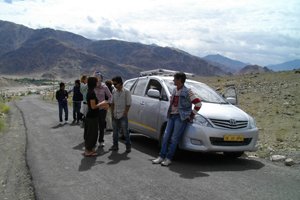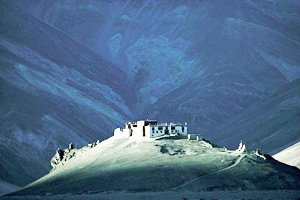
Zanskar valley tour is the best Himalayan nestled in the Znaskar valley is the most enchanting places to visit in Himalayas and the Zanskar valley is located in the lap of Great Himalayan Range and Zanskar Range. Suru valley is one of the most beautiful scenic valley of Ladakh region on the way visit Rock statue of Lord Buddha of Kartse Khar dating back to the 7th century and visit Rangdum monastery in Zanskar valley is a hidden treasure for tourism to explore the Zanskar valley.
A great Himalayan snow peak are seen on the way to Zanskar via Pezila pass and the view of the Popular Drang-Drung glacier gives you the prefect tongue-like glacier-view of the nature stark beauty. The Suru valley is the most beautiful place of alpine pasture land and natural scenic beauty and the majestic peak which enhance the stunning skyline beauty of Suru valley and the most attractive peak destination are also seen on the way to Zanskar and after the mount Everest, the NUN-KUN paek has been considered as a mini Everest to the adventure lover.
Day 1. Leh palace, Red Gonpa and Shanti Stupa.
The legendary Leh-palace was built on the granite hill in 16th century during the reign of Loin king Sengay Namgail. The nine-storeys building which magnificently dominating the view of Leh town is stood out tall despite the central Asian invasion.
Tsemo Gonpa was built on the hill top above the Leh palace in 14th century during the King Tashi Namgail and the chapel represent the reunification of upper and lower Ladakh over central Asian invader and also known as victory peak.
Shanti Stupa was built by Japanese people for peace, harmony and prosperity in the world and it was inaugurated by the His holiness the 14th Dalai Lama in 1985. From the stupa you can catch up the surpassing view Indus valley and the Stok Kangri of Zanskar mountain Range.
Day 2. Shey palace, Thiksay and Hemis monastery.
The old Shey palace of the Ladakh built in 550 years ago by the first king Lhachan Splagyion of Ladakh and the palace has largest golden Buddha statue in Ladakh, the statue worked out of gold and gilded copper sheet was built in 17th century. From the palace you can have a look over the fertile Indus plain and the Indus to Zanskar mountain range.
Thiksay monastery is the oldest monastery of Gelugpa School in Ladakh on the prophesy of great Lama Tsongkhapa the founder of Gylukpa school his disciples great Lama Sharap Zangpo of stod and his nephew Paldan Sharap built the monastery on the bank of Indus river in 14th century and this monastery is as beautiful as comparison to Potala palace and it is known as mini Potala. In 1980 the giant statue of future Buddha was erected and the monastery has largest contingents of monks in Ladakh.
Hemis monastery is located in the hidden mountain of Stok range, Hemis monastery is the school of Drukpa of Tibetan Buddhism was founded by the first reincarnation of Lama Stakstang Raspa from Tibet in 16th century with the support of ladakhi King Sengay Namgail. The festival of this monastery is very popular which held in summer.
Day 3. Basgo castle, Alchi Lamayuru monastery.
Basgo In the 10th century when the Yarklung dynasty was founded from Tibet, Bsgos was the western boundary of the kingdom. In 14th century Ladakh dynasty was divided between Basgo and Shey and then in 1470 the king Bhagan from Basgo overcome his cousin in Shey and united the upper and lower Ladakh and moved the capital to leh the Leh palace is living evidience and founded Namail Dynasty.
Alchi monastery :
The world famous monastery built in the 11th century by the great translator Lama Rinchen Zangpo. Alchi monastery is one of the 108 temples built by Lama Rinchen Zangpo from Guge of western Tibet. The world class Mandala and murals of Alchi different from the rest as it has a fusion of Tibetants and Kashmiri arts.
Lamayuru Visit the 11th century most spectacular picturesque monastery in central Ladakh and is believed to be the oldest and to have been the holy place of the Bon-chos at the advent of Buddhism. The site of lamayuru was lake ages back, when the Arhar Madyantika the disciple of Buddha was travelled to Kashmir and on his way to Ladakh halt for prayer at this place where he tossed grains during his prayer for blessing and he prophesied in future here would arise religious community and later the offered grains in the lake become shape of sawastika and the name of monastery today known as Yungdrung which meant sawastika and also today famously known as a moonland.
Day 4 Mulbek/Kargil , Rangdum.
Kargil region is one of the erstwhile kingdom of ladakh is situated along the Suru river and Waka Chu and Kargil town is located over equidistant from Leh, Srinagar and Zanskar.
Kargil has been merchandise center for central Asia. The ethnic and cultural affinity and influence are emanating from their neighbor’s region. The Indo-Aryan Mon, Dards and the Tibetant nomads are the first inhabitant of the Suru valley, originally people of Suru valley once has been a Buddhist area, later on , Shai Muslim were introduced by the central Asian and Kashmiri missionaries around in 15th century.
Suru valley is the most beautiful place of alpine pasture land and natural scenic beauty as well. As the great Himalayan magnificent towering peaks like the majestic NUN and KUN peak which enhance the stunning skyline beauty of the Suru valley.
Rnagdum gonpa was founded by Lobsang gylak Eshay Drakspa Nritsang during the King Tsewang Namgail and is the branch monastery belongs to the Naritsnag monastery. The reincarnation of Naris tulkhu acts as an incumbent of the monastery. It is located on a ball of hill in the lap of NUN-KUN range and Zanskar mountain range.
Day 5. Zanskar
The pre-historic sculptures in Zanskar have suggested that the Zanskar has been inhabited since a long time ago. The great Skide-Nimagon ruled over the Guge in the western Tibet around 990 AD including Ladakh and Zanskar. Historical Guru Padma Sambava visted Zanskar in 8th century AD and flourished Buddhism throughout the Zansakr and constructed Nanam Guru Stupa and Sani kanishka Stupa.
Day 6. Zangla palace, Stonday and Karsha monaster.
Zangla palace,Alexander csoma de koros: A Hungarian scholar came in search of the origin of the Hungarian and on 26th june 1823 He reached zangla village in zanskar and The zangla castle and phukthar monastery was the best institution and school of Tibetan Buddhism and home to zanskar most famous visitor,The Hungarian scholar, Alexander Csoma de koros who has studied the Tibetan language ,religion and compiled the English-Tibetan dictionary published in 1834 and Csoma de koros is regarded as a father of tibetology and he was converted to Buddhism in zanskar even before the Tibet.
Stonday monastery was founded in 950 year ago by renowned Lama Marpa and it is known as Marpaling monastery. Lama Gyal Stanba Lundup Spalzangpo introduced the yellow cap order of the Tibetan Buddhism and there aremany beautiful shrines to be visit and monastic festival take place every year according to the Tibetan calendar and the reincarnation of Naris tulkhu acts as an incumbent of the monastery.
Karsha monastery is the largest monastery in Zanskar was founded by Zanskar Lotswa Phakspa Sharap. The present monastery was flourished under the Dorjay Sharap and the yellow cap order of Tibetan Buddhism of lord Tsonkhapa was introduced by Sharap Zangpo of Stod and Karsha monastic festival which held according to tibetant calendar in summer. The monastery majestically located on Steep Mountain facing toward the center valley.
Day 7. Bardan, Zongkhul monastery and Sani castle.
Bardan monastery was founded by bodhisattva Daba Gytso about four hundred years ago and is built on the top cliff rock of the river Tserap to the south of Padum. The reincarnation of Stakna Tulku acts as incumbent of the monastery and is branch of Stakna monastery.
Zongkhul monastery was founded by Lama panchen Naropa about 990 years ago and is located to the south west of padum in hidden gorge valley of omasi-la trek. the meditation cave and Panchen Naropa footprint embedded in the rock his sacred spring, therefore it became it became sacred mediation cave for all the yogis.
Sani castle the sani is a sacred place and blessed by guru padmasambawan is equall in importance to the cemetery of DechanDal in India and the meditation cave and foot-print of Guru Nina odzar can be seen on the opposite side of the river and lama Naropa also visited sani and his sacred image are seen on the day of sani festival to the pilgrimage. Kanika stupa is the lodest stupa in ladakh and its foundation is associated with King Kanishka the 2nd century AD Kushan ruler.
 Day 8. Zanskar to Kargil.
Day 8. Zanskar to Kargil.
Day 9. kargil to Leh.
Day 10. Fly Leh to Delhi.
OR
Day 9. Kargil to Kashamir.
Day 10. Kashmir sightseeing.
Day 11. Fly Kashmir to Dehi.

